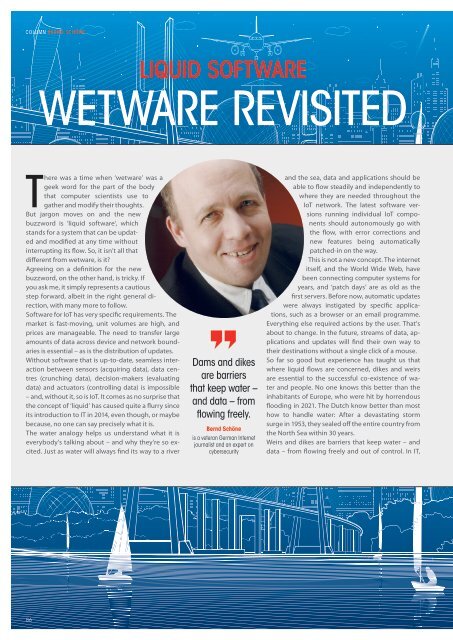Smart Industry No.1 2022
Smart Industry No.1 2022 - The IoT Business Magazine - powered by Avnet Silica
Smart Industry No.1 2022 - The IoT Business Magazine - powered by Avnet Silica
Create successful ePaper yourself
Turn your PDF publications into a flip-book with our unique Google optimized e-Paper software.
Column Bernd Schöne<br />
Liquid Software<br />
Wetware Revisited<br />
There was a time when ‘wetware’ was a<br />
geek word for the part of the body<br />
that computer scientists use to<br />
gather and modify their thoughts.<br />
But jargon moves on and the new<br />
buzzword is ‘liquid software’, which<br />
stands for a system that can be updated<br />
and modified at any time without<br />
interrupting its flow. So, it isn’t all that<br />
different from wetware, is it?<br />
Agreeing on a definition for the new<br />
buzzword, on the other hand, is tricky. If<br />
you ask me, it simply represents a cautious<br />
step forward, albeit in the right general direction,<br />
with many more to follow.<br />
Software for IoT has very specific requirements. The<br />
market is fast-moving, unit volumes are high, and<br />
prices are manageable. The need to transfer large<br />
amounts of data across device and network boundaries<br />
is essential – as is the distribution of updates.<br />
Without software that is up-to-date, seamless interaction<br />
between sensors (acquiring data), data centres<br />
(crunching data), decision-makers (evaluating<br />
data) and actuators (controlling data) is impossible<br />
– and, without it, so is IoT. It comes as no surprise that<br />
the concept of ‘liquid’ has caused quite a flurry since<br />
its introduction to IT in 2014, even though, or maybe<br />
because, no one can say precisely what it is.<br />
The water analogy helps us understand what it is<br />
everybody’s talking about – and why they’re so excited.<br />
Just as water will always find its way to a river<br />
Dams and dikes<br />
are barriers<br />
that keep water –<br />
and data – from<br />
flowing freely.<br />
Bernd Schöne<br />
is a veteran German Internet<br />
journalist and an expert on<br />
cybersecurity<br />
and the sea, data and applications should be<br />
able to flow steadily and independently to<br />
where they are needed throughout the<br />
IoT network. The latest software versions<br />
running individual IoT components<br />
should autonomously go with<br />
the flow, with error corrections and<br />
new features being automatically<br />
patched-in on the way.<br />
This is not a new concept. The internet<br />
itself, and the World Wide Web, have<br />
been connecting computer systems for<br />
years, and ‘patch days’ are as old as the<br />
first servers. Before now, automatic updates<br />
were always instigated by specific applications,<br />
such as a browser or an email programme.<br />
Everything else required actions by the user. That's<br />
about to change. In the future, streams of data, applications<br />
and updates will find their own way to<br />
their destinations without a single click of a mouse.<br />
So far so good but experience has taught us that<br />
where liquid flows are concerned, dikes and weirs<br />
are essential to the successful co-existence of water<br />
and people. No one knows this better than the<br />
inhabitants of Europe, who were hit by horrendous<br />
flooding in 2021. The Dutch know better than most<br />
how to handle water: After a devastating storm<br />
surge in 1953, they sealed off the entire country from<br />
the North Sea within 30 years.<br />
Weirs and dikes are barriers that keep water – and<br />
data – from flowing freely and out of control. In IT,<br />
86
















